Romantic literature
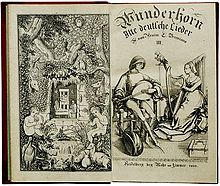
In literature, Romanticism found recurrent themes in the evocation or criticism of the past, the cult of "sensibility" with its emphasis on women and children, the isolation of the artist or narrator, and respect for nature. Furthermore, several romantic authors, such as Edgar Allan Poe, Charles Maturin and Nathaniel Hawthorne, based their writings on the supernatural/occult and human psychology. Romanticism tended to regard satire as something unworthy of serious attention, a view still influential today.[1] The Romantic movement in literature was preceded by the Enlightenment and succeeded by Realism.
Some authors cite 16th-century poet Isabella di Morra as an early precursor of Romantic literature. Her lyrics covering themes of isolation and loneliness, which reflected the tragic events of her life, are considered "an impressive prefigurement of Romanticism",[2] differing from the Petrarchist fashion of the time based on the philosophy of love.
The precursors of Romanticism in English poetry go back to the middle of the 18th century, including figures such as
Germany
An early German influence came from
Important motifs in German Romanticism are travelling, nature, for example the
Great Britain
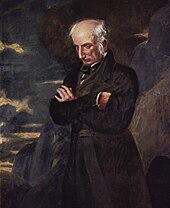
In English literature, the key figures of the Romantic movement are considered to be the group of poets including William Wordsworth, Samuel Taylor Coleridge, John Keats, Lord Byron, Percy Bysshe Shelley and the much older William Blake, followed later by the isolated figure of John Clare; also such novelists as Walter Scott from Scotland and Mary Shelley, and the essayists William Hazlitt and Charles Lamb. The publication in 1798 of Lyrical Ballads, with many of the finest poems by Wordsworth and Coleridge, is often held to mark the start of the movement. The majority of the poems were by Wordsworth, and many dealt with the lives of the poor in his native Lake District, or his feelings about nature—which he more fully developed in his long poem The Prelude, never published in his lifetime. The longest poem in the volume was Coleridge's The Rime of the Ancient Mariner, which showed the Gothic side of English Romanticism, and the exotic settings that many works featured. In the period when they were writing, the Lake Poets were widely regarded as a marginal group of radicals, though they were supported by the critic and writer William Hazlitt and others.

In contrast,
In contrast to Germany, Romanticism in English literature had little connection with nationalism, and the Romantics were often regarded with suspicion for the sympathy many felt for the ideals of the French Revolution, whose collapse and replacement with the dictatorship of Napoleon was, as elsewhere in Europe, a shock to the movement. Though his novels celebrated Scottish identity and history, Scott was politically a firm Unionist, but admitted to Jacobite sympathies. Several Romantics spent much time abroad, and a famous stay on Lake Geneva with Byron and Shelley in 1816 produced the hugely influential novel Frankenstein by Shelley's wife-to-be Mary Shelley and the novella The Vampyre by Byron's doctor John William Polidori. The lyrics of Robert Burns in Scotland, and Thomas Moore from Ireland, reflected in different ways their countries and the Romantic interest in folk literature, but neither had a fully Romantic approach to life or their work.
Though they have modern critical champions such as György Lukács, Scott's novels are today more likely to be experienced in the form of the many operas that composers continued to base on them over the following decades, such as Donizetti's Lucia di Lammermoor and Vincenzo Bellini's I puritani (both 1835). Byron is now most highly regarded for his short lyrics and his generally unromantic prose writings, especially his letters, and his unfinished satire Don Juan.[10] Unlike many Romantics, Byron's widely publicised personal life appeared to match his work, and his death at 36 in 1824 from disease when helping the Greek War of Independence appeared from a distance to be a suitably Romantic end, entrenching his legend.[11] Keats in 1821 and Shelley in 1822 both died in Italy, Blake (at almost 70) in 1827, and Coleridge largely ceased to write in the 1820s. Wordsworth was by 1820 respectable and highly regarded, holding a government sinecure, but wrote relatively little. In the discussion of English literature, the Romantic period is often regarded as finishing around the 1820s, or sometimes even earlier, although many authors of the succeeding decades were no less committed to Romantic values.
The most significant novelist in English during the peak Romantic period, other than Walter Scott, was Jane Austen, whose essentially conservative world-view had little in common with her Romantic contemporaries, retaining a strong belief in decorum and social rules, though critics such as Claudia L. Johnson have detected tremors under the surface of many works, such as Northanger Abbey (1817), Mansfield Park (1814) and Persuasion (1817).[12] But around the mid-century the undoubtedly Romantic novels of the Yorkshire-based Brontë family appeared, most notably Charlotte's Jane Eyre and Emily's Wuthering Heights, both published in 1847, which also introduced more Gothic themes. While these two novels were written and published after the Romantic period is said to have ended, their novels were heavily influenced by Romantic literature they had read as children.
Byron, Keats, and Shelley all wrote for the stage, but with little success in England, with Shelley's The Cenci perhaps the best work produced, though that was not played in a public theatre in England until a century after his death. Byron's plays, along with dramatizations of his poems and Scott's novels, were much more popular on the Continent, and especially in France, and through these versions several were turned into operas, many still performed today. If contemporary poets had little success on the stage, the period was a legendary one for performances of Shakespeare, and went some way to restoring his original texts and removing the Augustan "improvements" to them. The greatest actor of the period, Edmund Kean, restored the tragic ending to King Lear;[13] Coleridge said that "Seeing him act was like reading Shakespeare by flashes of lightning."[14]
Scotland

Although after
Robert Burns (1759–96) and Walter Scott (1771–1832) were highly influenced by the Ossian cycle. Burns, an Ayrshire poet and lyricist, is widely regarded as the national poet of Scotland and a major influence on the Romantic movement. His poem (and song) "Auld Lang Syne" is often sung at Hogmanay (the last day of the year), and "Scots Wha Hae" served for a long time as an unofficial national anthem of the country.[19] Scott began as a poet and also collected and published Scottish ballads. His first prose work, Waverley in 1814, is often called the first historical novel.[20] It launched a highly successful career, with other historical novels such as Rob Roy (1817), The Heart of Midlothian (1818) and Ivanhoe (1820). Scott probably did more than any other figure to define and popularise Scottish cultural identity in the nineteenth century.[21] Other major literary figures connected with Romanticism include the poets and novelists James Hogg (1770–1835), Allan Cunningham (1784–1842) and John Galt (1779–1839).[22]
Scottish "national drama" emerged in the early 1800s, as plays with specifically Scottish themes began to dominate the Scottish stage. Theatres had been discouraged by the Church of Scotland and fears of Jacobite assemblies. In the later eighteenth century, many plays were written for and performed by small amateur companies and were not published and so most have been lost. Towards the end of the century there were "closet dramas", primarily designed to be read, rather than performed, including work by Scott, Hogg, Galt and Joanna Baillie (1762–1851), often influenced by the ballad tradition and Gothic Romanticism.[26]
France
Romanticism was relatively late in developing
After the
French Romantic poets of the 1830s to 1850s include Alfred de Musset, Gérard de Nerval, Alphonse de Lamartine and the flamboyant Théophile Gautier, whose prolific output in various forms continued until his death in 1872.
Stendhal is today probably the most highly regarded French novelist of the period, but he stands in a complex relation with Romanticism, and is notable for his penetrating psychological insight into his characters and his realism, qualities rarely prominent in Romantic fiction. As a survivor of the French retreat from Moscow in 1812, fantasies of heroism and adventure had little appeal for him, and like Goya he is often seen as a forerunner of Realism. His most important works are Le Rouge et le Noir (The Red and the Black, 1830) and La Chartreuse de Parme (The Charterhouse of Parma, 1839).
Poland

Romanticism in Poland is often taken to begin with the publication of Adam Mickiewicz's first poems in 1822, and end with the crushing of the January Uprising of 1863 against the Russians. It was strongly marked by interest in Polish history.[31] Polish Romanticism revived the old "Sarmatism" traditions of the szlachta or Polish nobility. Old traditions and customs were revived and portrayed in a positive light in the Polish messianic movement and in works of great Polish poets such as Adam Mickiewicz (Pan Tadeusz), Juliusz Słowacki and Zygmunt Krasiński. This close connection between Polish Romanticism and Polish history became one of the defining qualities of the literature of Polish Romanticism period, differentiating it from that of other countries. They had not suffered the loss of national statehood as was the case with Poland.[32] Influenced by the general spirit and main ideas of European Romanticism, the literature of Polish Romanticism is unique, as many scholars have pointed out, in having developed largely outside of Poland and in its emphatic focus upon the issue of Polish nationalism. The Polish intelligentsia, along with leading members of its government, left Poland in the early 1830s, during what is referred to as the "Great Emigration", resettling in France, Germany, Great Britain, Turkey, and the United States.
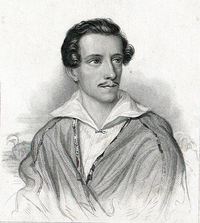
Their art featured
Russia
Early Russian Romanticism is associated with the writers Konstantin Batyushkov (A Vision on the Shores of the Lethe, 1809), Vasily Zhukovsky (The Bard, 1811; Svetlana, 1813) and Nikolay Karamzin (Poor Liza, 1792; Julia, 1796; Martha the Mayoress, 1802; The Sensitive and the Cold, 1803). However the principal exponent of Romanticism in Russia is Alexander Pushkin (The Prisoner of the Caucasus, 1820–1821; The Robber Brothers, 1822; Ruslan and Ludmila, 1820; Eugene Onegin, 1825–1832). Pushkin's work influenced many writers in the 19th century and led to his eventual recognition as Russia's greatest poet.[33] Other Russian Romantic poets include Mikhail Lermontov (A Hero of Our Time, 1839), Fyodor Tyutchev (Silentium!, 1830), Yevgeny Baratynsky (Eda, 1826), Anton Delvig, and Wilhelm Küchelbecker.
Influenced heavily by Lord Byron, Lermontov sought to explore the Romantic emphasis on metaphysical discontent with society and self, while Tyutchev's poems often described scenes of nature or passions of love. Tyutchev commonly operated with such categories as night and day, north and south, dream and reality, cosmos and chaos, and the still world of winter and spring teeming with life. Baratynsky's style was fairly classical in nature, dwelling on the models of the previous century.
Spain

There are scholars who consider Spanish Romanticism to be Proto-Existentialism because it is more anguished than the movement in other European countries. Foster et al., for example, say that the work of Spain's writers such as Espronceda, Larra, and other writers in the 19th century demonstrated a "metaphysical crisis".[37] These observers put more weight on the link between the 19th-century Spanish writers with the existentialist movement that emerged immediately after. According to Richard Caldwell, the writers that we now identify with Spain's romanticism were actually precursors to those who galvanized the literary movement that emerged in the 1920s.[38] This notion is the subject of debate for there are authors who stress that Spain's romanticism is one of the earliest in Europe,[39] while some assert that Spain really had no period of literary romanticism.[40] This controversy underscores a certain uniqueness to Spanish Romanticism in comparison to its European counterparts.
Portugal

Romanticism began in Portugal with the publication of the poem Camões (1825), by Almeida Garrett, who was raised by his uncle D. Alexandre, bishop of Angra, in the precepts of Neoclassicism, which can be observed in his early work. The author himself confesses (in Camões' preface) that he voluntarily refused to follow the principles of epic poetry enunciated by Aristotle in his Poetics, as he did the same to Horace's Ars Poetica. Almeida Garrett had participated in the 1820 Liberal Revolution, which caused him to exile himself in England in 1823 and then in France, after the Vila-Francada. While living in Great Britain, he had contacts with the Romantic movement and read authors such as Shakespeare, Scott, Ossian, Byron, Hugo, Lamartine and de Staël, at the same time visiting feudal castles and ruins of Gothic churches and abbeys, which would be reflected in his writings. In 1838, he presented Um Auto de Gil Vicente ("A Play by Gil Vicente"), in an attempt to create a new national theatre, free of Greco-Roman and foreign influence. But his masterpiece would be Frei Luís de Sousa (1843), named by himself as a "Romantic drama" and it was acclaimed as an exceptional work, dealing with themes as national independence, faith, justice and love. He was also deeply interested in Portuguese folkloric verse, which resulted in the publication of Romanceiro ("Traditional Portuguese Ballads") (1843), that recollect a great number of ancient popular ballads, known as "romances" or "rimances", in redondilha maior verse form, that contained stories of chivalry, life of saints, crusades, courtly love, etc. He wrote the novels Viagens na Minha Terra, O Arco de Sant'Ana and Helena.[41][42][43]
Alexandre Herculano is, alongside Almeida Garrett, one of the founders of Portuguese Romanticism. He too was forced to exile to Great Britain and France because of his liberal ideals. All of his poetry and prose are (unlike Almeida Garrett's) entirely Romantic, rejecting Greco-Roman myth and history. He sought inspiration in medieval Portuguese poems and chronicles as in the Bible. His output is vast and covers many different genres, such as historical essays, poetry, novels, opuscules and theatre, where he brings back a whole world of Portuguese legends, tradition and history, especially in Eurico, o Presbítero ("Eurico, the Priest") and Lendas e Narrativas ("Legends and Narratives"). His work was influenced by Chateaubriand, Schiller, Klopstock, Walter Scott and the Old Testament Psalms.[44]
António Feliciano de Castilho made the case for Ultra-Romanticism, publishing the poems A Noite no Castelo ("Night in the Castle") and Os Ciúmes do Bardo ("The Jealousy of the Bard"), both in 1836, and the drama Camões. He became an unquestionable master for successive Ultra-Romantic generations, whose influence would not be challenged until the famous Coimbra Question. He also created polemics by translating Goethe's Faust without knowing German, but using French versions of the play. Other notable figures of Portuguese Romanticism are the famous novelists Camilo Castelo Branco and Júlio Dinis, and Soares de Passos, Bulhão Pato and Pinheiro Chagas.[43]
Romantic style would be revived in the beginning of the 20th century, notably through the works of poets linked to the
Italy
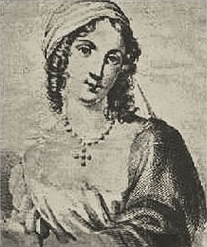
Romanticism in Italian literature was a minor movement although some important works were produced; it began officially in 1816 when Germaine de Staël wrote an article in the journal Biblioteca italiana called "Sulla maniera e l'utilità delle traduzioni", inviting Italian people to reject Neoclassicism and to study new authors from other countries. Before that date, Ugo Foscolo had already published poems anticipating Romantic themes. The most important Romantic writers were Ludovico di Breme, Pietro Borsieri and Giovanni Berchet.[46] Better known authors such as Alessandro Manzoni and Giacomo Leopardi were influenced by Enlightenment as well as by Romanticism and Classicism.[47] An Italian romanticist writer who produced works in various genres, including short stories and novels (such as Ricciarda o i Nurra e i Cabras), was the Piedmontese Giuseppe Botero (1815–1885), devoting much of his career to Sardinian literature.[48]
South America
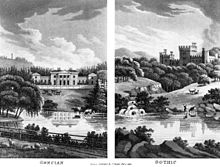
Spanish-speaking South American Romanticism was influenced heavily by Esteban Echeverría, who wrote in the 1830s and 1840s. His writings were influenced by his hatred for the Argentine dictator Juan Manuel de Rosas, and filled with themes of blood and terror, using the metaphor of a slaughterhouse to portray the violence of Rosas' dictatorship.
Brazilian Romanticism is characterized and divided in three different periods. The first one is basically focused on the creation of a sense of national identity, using the ideal of the heroic Indian. Some examples include José de Alencar, who wrote Iracema and O Guarani, and Gonçalves Dias, renowned by the poem "Canção do exílio" (Song of the Exile). The second period, sometimes called Ultra-Romanticism, is marked by a profound influence of European themes and traditions, involving the melancholy, sadness and despair related to unobtainable love. Goethe and Lord Byron are commonly quoted in these works. Some of the most notable authors of this phase are Álvares de Azevedo, Casimiro de Abreu, Fagundes Varela and Junqueira Freire. The third cycle is marked by social poetry, especially the abolitionist movement, and it includes Castro Alves, Tobias Barreto and Pedro Luís Pereira de Sousa.[49]

United States
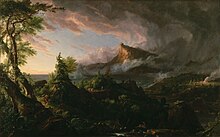
In the United States, at least by 1818 with William Cullen Bryant's "
European influence
The European Romantic movement reached America in the early 19th century. American Romanticism was just as multifaceted and individualistic as it was in Europe. Like the Europeans, the American Romantics demonstrated a high level of moral enthusiasm, commitment to individualism and the unfolding of the self, an emphasis on intuitive perception, and the assumption that the natural world was inherently good, while human society was filled with corruption.[50]
Romanticism became popular in American politics, philosophy and art. The movement appealed to the revolutionary spirit of America as well as to those longing to break free of the strict religious traditions of early settlement. The Romantics rejected rationalism and religious intellect. It appealed to those in opposition of Calvinism, which includes the belief that the destiny of each individual is preordained. The Romantic movement gave rise to New England Transcendentalism, which portrayed a less restrictive relationship between God and Universe. The new philosophy presented the individual with a more personal relationship with God. Transcendentalism and Romanticism appealed to Americans in a similar fashion, for both privileged feeling over reason, individual freedom of expression over the restraints of tradition and custom. It often involved a rapturous response to nature. It encouraged the rejection of harsh, rigid Calvinism, and promised a new blossoming of American culture.[50][51]
American Romanticism embraced the individual and rebelled against the confinement of neoclassicism and religious tradition. The Romantic movement in America created a new literary genre that continues to influence American writers. Novels, short stories, and poems replaced the sermons and manifestos of yore. Romantic literature was personal, intense, and portrayed more emotion than ever seen in neoclassical literature. America's preoccupation with freedom became a great source of motivation for Romantic writers as many were delighted in free expression and emotion without so much fear of ridicule and controversy. They also put more effort into the psychological development of their characters, and the main characters typically displayed extremes of sensitivity and excitement.[52]
The works of the Romantic Era also differed from preceding works in that they spoke to a wider audience, partly reflecting the greater distribution of books as costs came down during the period.[53]
References
- ^ Sutherland, James (1958) English Satire Archived 2022-12-04 at the Wayback Machine p. 1. There were a few exceptions, notably Byron, who integrated satire into some of his greatest works, yet shared much in common with his Romantic contemporaries. Bloom, p. 18.
- ^ Paul F. Grendler, Renaissance Society of America, Encyclopedia of the Renaissance, Scribner, 1999, p. 193
- ^ John Keats. By Sidney Colvin, p. 106. Elibron Classics
- ^ Thomas Chatterton, Grevel Lindop, 1972, Fyffield Books, p. 11
- ISBN 978-0-415-90081-2.
- ISBN 978-0-19-860115-9.
- ISBN 978-0-230-55500-6
- ^ Christiansen, 215.
- ^ Christiansen, 192–96.
- ^ Christiansen, 197–200.
- ^ Christiansen, 213–20.
- ^ Christiansen, 188–89.
- ^ Or at least he tried to; Kean played the tragic Lear for a few performances. They were not well received, and with regret, he reverted to Nahum Tate's version with a comic ending, which had been standard since 1689. See Stanley Wells, "Introduction" from King Lear, Oxford University Press (2000), p. 69.
- ^ Coleridge, Samuel Taylor, Table Talk, 27 April 1823 in Coleridge, Samuel Taylor; Morley, Henry (1884). Table Talk of Samuel Taylor Coleridge and The Rime of the Ancient Mariner, Christobel, &c. New York: Routledge. p. 38.
- ISBN 0-06-055888-1, p. 311.
- ISBN 0-06-055888-1, p. 163.
- ISBN 0-8264-6135-2, p. 140.
- ^ D. Thomson, The Gaelic Sources of Macpherson's "Ossian" (Aberdeen: Oliver & Boyd, 1952).
- ^ L. McIlvanney, "Hugh Blair, Robert Burns, and the Invention of Scottish Literature", Eighteenth-Century Life, vol. 29 (2), Spring 2005, pp. 25–46.
- ISBN 0-7546-6142-3, p. 28.
- ISBN 0-7453-1608-5, p. 136.
- ISBN 0-8160-7496-8, p. 374.
- ISBN 0-631-23355-5, p. 60.
- ISBN 0-7546-6446-5, p. 210.
- ISBN 0-7546-6446-5, p. 209.
- ISBN 0-7486-2481-3, pp. 229–30.
- ^ Christiansen, 202–03, 241–42.
- ^ Christiansen, 239–46, 240 quoted.
- ^ Christiansen, 244–46.
- ^ Christiansen
- ^ Leon Dyczewski, Values in the Polish cultural tradition (2002) p. 183
- ^ Christopher J. Murray, Encyclopedia of the romantic era, 1760–1850 (2004) vol. 2. p. 742
- ^ "Alexander Sergeevich Pushkin (1799–1837)". University of Virginia Slavic Department. Archived from the original on 1 April 2019. Retrieved 1 August 2011.
- ^ "El escritor José de Espronceda". Museo del Prado (in Spanish). Madrid. Retrieved March 27, 2013.
- ^ Philip W. Silver, Ruin and restitution: reinterpreting romanticism in Spain (1997) p. 13
- ^ Gerald Brenan, The literature of the Spanish people: from Roman times to the present (1965) p. 364
- ISBN 978-0-8153-3563-4.
- JSTOR 3722555.
- ISBN 978-84-249-0591-0.
- JSTOR 3721247.
- ISBN 978-972-48-0192-6.
- ^ "Artigo de apoio Infopédia – Almeida Garrett". Infopédia – Dicionários Porto Editora (in European Portuguese). Retrieved 2018-04-03.
- ^ OCLC 35124986.
- ^ "Artigo de apoio Infopédia – Alexandre Herculano". Infopédia – Dicionários Porto Editora (in European Portuguese). Retrieved 2018-04-03.
- ^ Gaetana Marrone, Paolo Puppa, Encyclopedia of Italian Literary Studies: A–J, Taylor & Francis, 2007, p. 1242
- ^ Garofalo, Piero (2005). "Italian Romanticisms". In Ferber, Michael (ed.). Companion to European Romanticism. London: Blackwell. pp. 238–255.
- ^ La nuova enciclopedia della letteratura. Milan: Garzanti. 1985. p. 829.
- ISBN 978-88-8467-859-1. Archivedfrom the original on 19 March 2022. Retrieved 14 July 2022.
- ^ Roberto González Echevarría and Enrique Pupo-Walker, The Cambridge History of Latin American Literature: Brazilian Literature (1996) vol. 2 p. 367
- ^ a b George L. McMichael and Frederick C. Crews, eds. Anthology of American Literature: Colonial through romantic (6th ed. 1997) p. 613
- ^ "Romanticism, American", in The Oxford Dictionary of American Art and Artists ed by Ann Lee Morgan (Oxford University Press, 2007) online Archived 2020-07-28 at the Wayback Machine
- Another Weeping Woman" and its commentary.
- ^ Greenblatt et al., Norton Anthology of English Literature, eighth edition, "The Romantic Period – Volume D" (New York: W.W. Norton & Company Inc., 2006)
